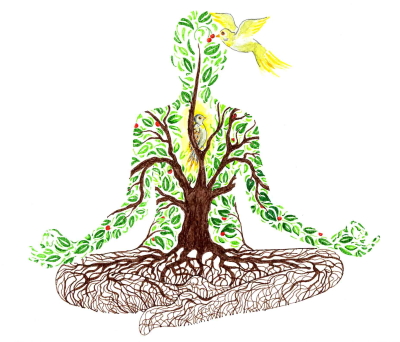Unity in Diversity
There is a beautiful verse from the Śvetaśvatara Upaniṣad that it is wise to keep in mind:
dva suparna sayujā sakhāya samāniṁ vṛśaṁ parīṣasvajāte |
tayoranyaḥ pīppalaṁ svādvattya naśnannanyo abhicākaśīti || 3 : 6 ||
Closely united, and of equal beauty, two birds sit on the same tree.
One eats and enjoys the fruit of the tree while the other is the silent witness.
It does seem, as long as we physically walk this earth, we do so with this dual embodiment: both physical and spiritual; we are indeed a unity in diversity. Our physicality ~ that bird eating the fruits of life ~ grabs our attention in a very immediate kind of way as we navigate everyday life. Every 'hierarchy of needs' seems to be centred around this physicality of being ~ from the need for shelter, food, and affection to the need for approval and recognition.
All the while, the bird that watches ~ the spiritual self ~ is present in silence.
Awareness
A friend, who also learnt at the feet of Swami Venkatesananda, Judy Tobler, shared with me something Swamiji had written to her when she had asked about the dilemma facing us as we tried to walk a spiritual path in the world:
"If one is inwardly awake and alert, then every experience in your life becomes the guru and every moment of life becomes the practice of yoga. It is true that one may get lost in what is called a worldly life on account of attachment, selfishness, etc., but these dangers are present in the so-called spiritual life, too. There is no alternative to keeping awake.".
~ Swami Venkatesananda
This reminds me of The Katha Upanishad, which offers the beautiful metaphor of the chariot: the chariot is the body making its way along the road of life, the horses are the senses, the reins are the mind conveying all that the senses encounter back to the awareness, and the awareness is the chariot driver, holding the reins. Seated out of sight in the back of the chariot is the owner.
Buddhi is the Sanskrit word for that awareness ~ which is often incorrectly translated as 'intelligence,' but it is not that. Buddhi is the centre of discernment; it is awareness.
As soon as this buddhi ~ awareness ~ becomes aware of that 'deeper' self, atman, it becomes buddha ~ the awakened. Then its reference point does a 180o shift.
If we look back at the beginning of the Ramayana, Sage Valmiki has just heard for the first time the enlightening story of Rama, when he encounters two birds sporting happily with each other. Suddenly a hunter appears on the scene and kills one of the pair. Valmiki, in a flash of anger, utters a curse against the hunter ~ and then very quickly regrets it and says, 'May this be a verse and not a curse.'
Remember what we learned in our first lesson: The Ramayana is a purana, which is defined as that which is old, becoming new. Yes, it is an ancient story of a sage ~ indeed, sages ~ but we are called on to now look for this sage within ourselves. We are studying this scripture because we want to learn: about ourselves; about the meaning behind the things that happen to us. We are on the spiritual journey of uncovering all that we are. Then the Ramayana becomes something new, something from the past that is also of this moment.
One minute the hunter in us might want to kill the hunter in others ~ until it stops and listens to that silent witnessing bird, and then the sage in us makes a different choice
Whatever the circumstances, each of us chooses which way to go… which brings us to the two beautiful Katha Upanishad verses:
Yama said,
There are two paths:
One leads outward and the other inward.
You can walk the way outward that leads to pleasure
Or the way inward that leads to grace.
Of these two it is the path of grace,
Though concealed, that leads to the goal.
(2: 1)
Both of these paths lie before each person eternally.
It is the way of things.
Day by day, hour by hour, moment by moment,
The wise must distinguish one from the other ~
And for the sake of Yoga choose which one to walk.
The foolish, grasping first at this and then at that,
Choose to walk the path of pleasure.
(2: 2)
The responsibility of choice rests with each of us: to choose the path of the sage or the path of the hunter. Valmiki ~ the wise sage who was the first to receive the gift of the Ramayana, and Valmiki, the angry witness to a pointless killing, existed in the ancient past. However, both aspects of Valmiki continued in us through the ages, and even now ~ at every moment ~ we choose which we will act on this world.
Will our two birds fly wing to wing, or pull us in opposite directions? Then which way will we go?
Notes :
- In their book 'Sanskrit Non-Translatables' by Rajiv Malhotra and Satyanarayana Dasa Babaji, terms like buddhi are deeply explored. The authors encourage us to continue to use the Sanskrit words rather than distorting our understanding with inadequate translations.
- For more information of these two paths of The Katha Upanishad, please see a previous blog, 'Why Hesitate'.

©Swami Ambikananda, July 2025

